This document summarizes key points about HIV-associated lymphoma:
- HIV-associated lymphomas have improved in prognosis due to combination antiretroviral therapy and novel therapies, with many patients now cured.
- Diffuse large B-cell lymphoma and Burkitt lymphoma have excellent outcomes, similar to HIV-negative patients, especially with the addition of rituximab.
- New treatments are still needed to improve outcomes for patients with advanced immunosuppression or adverse tumor subtypes driven by viruses.
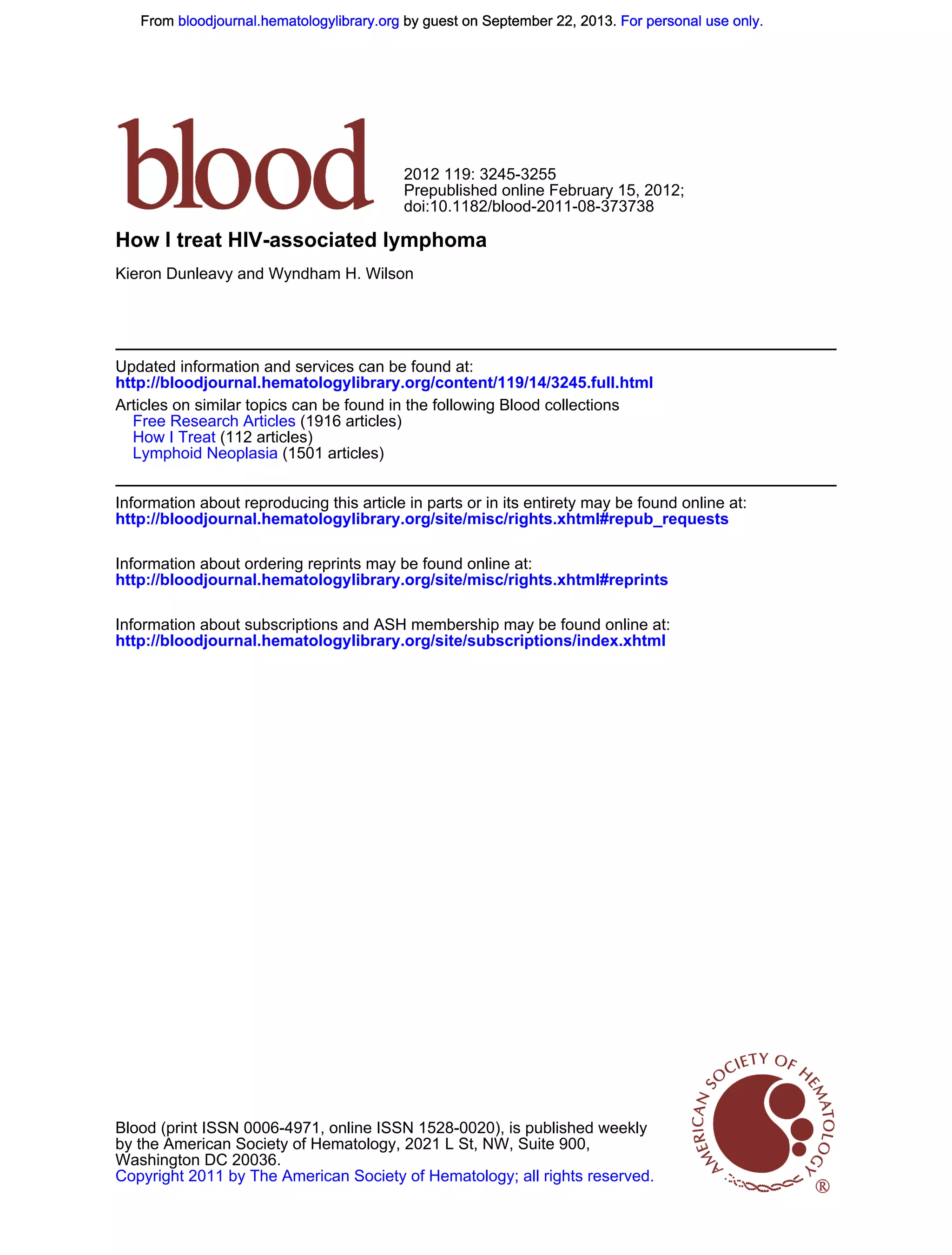
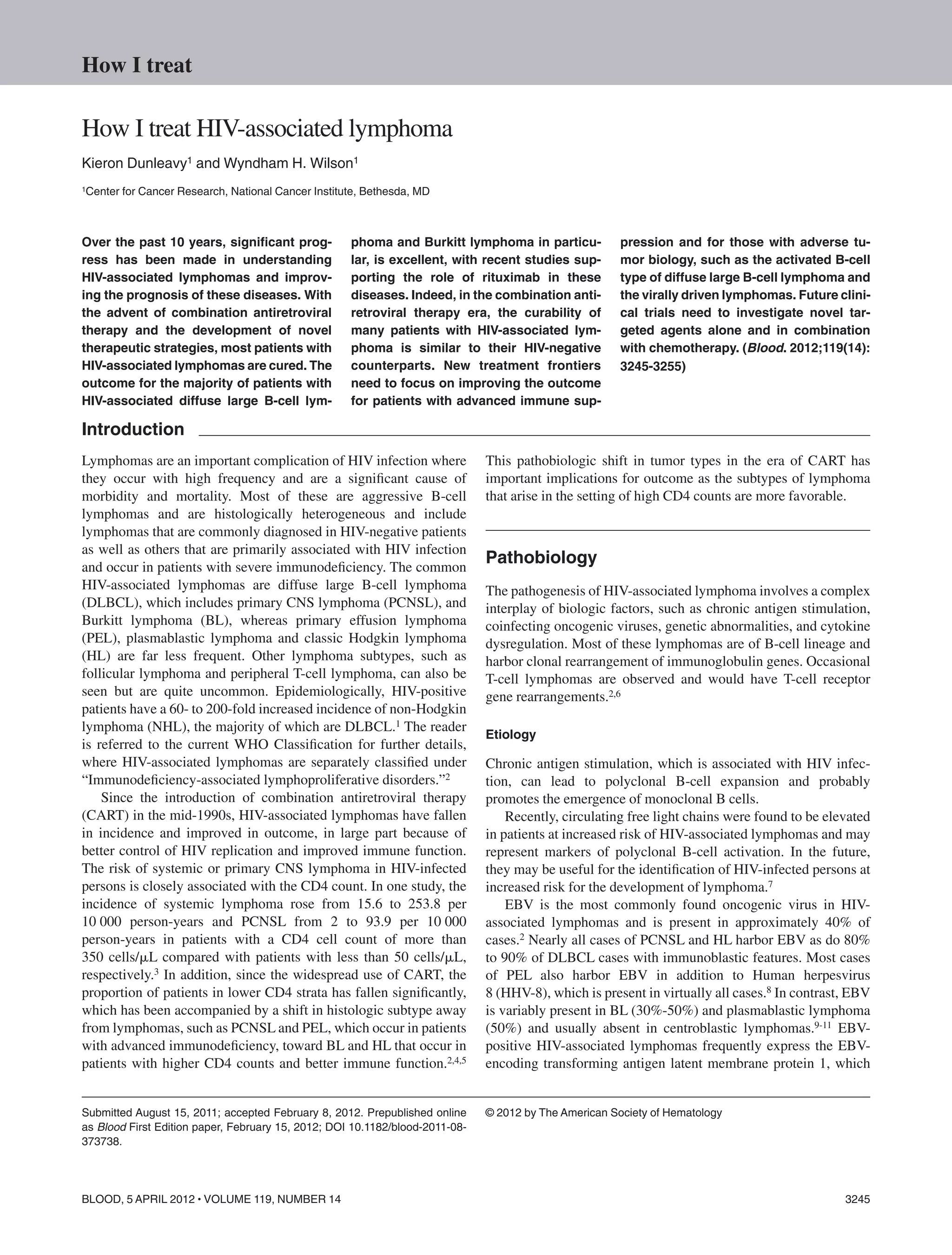
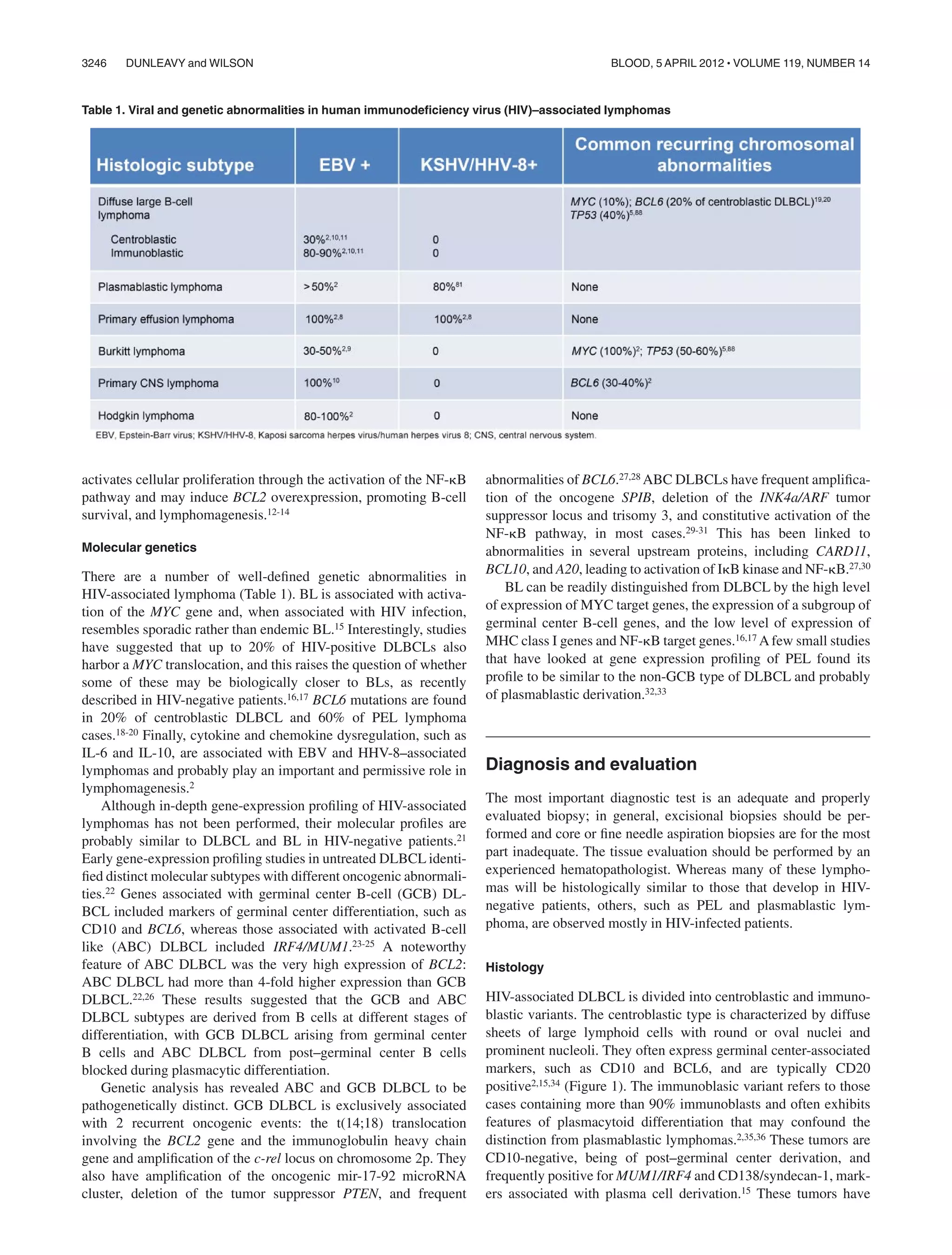
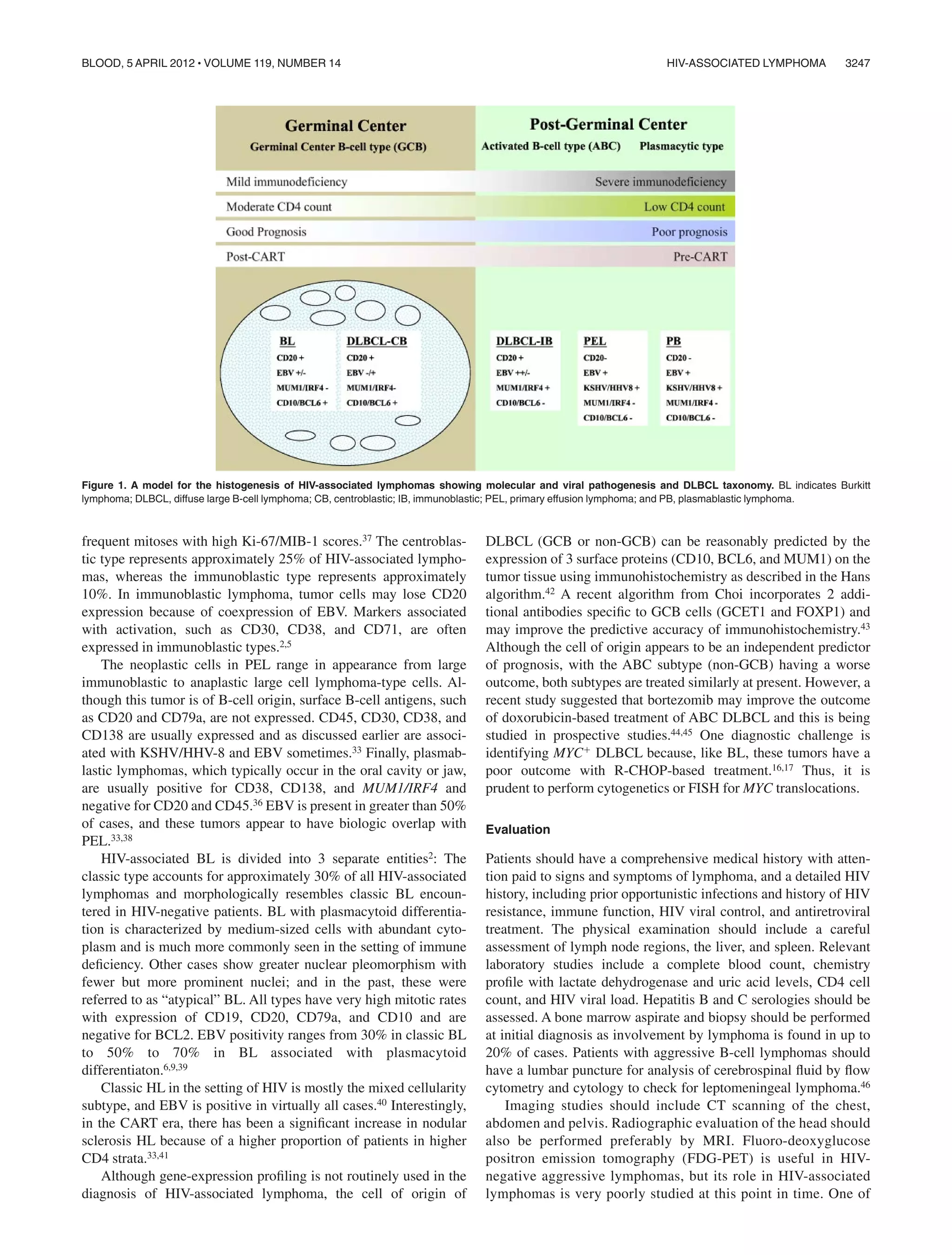
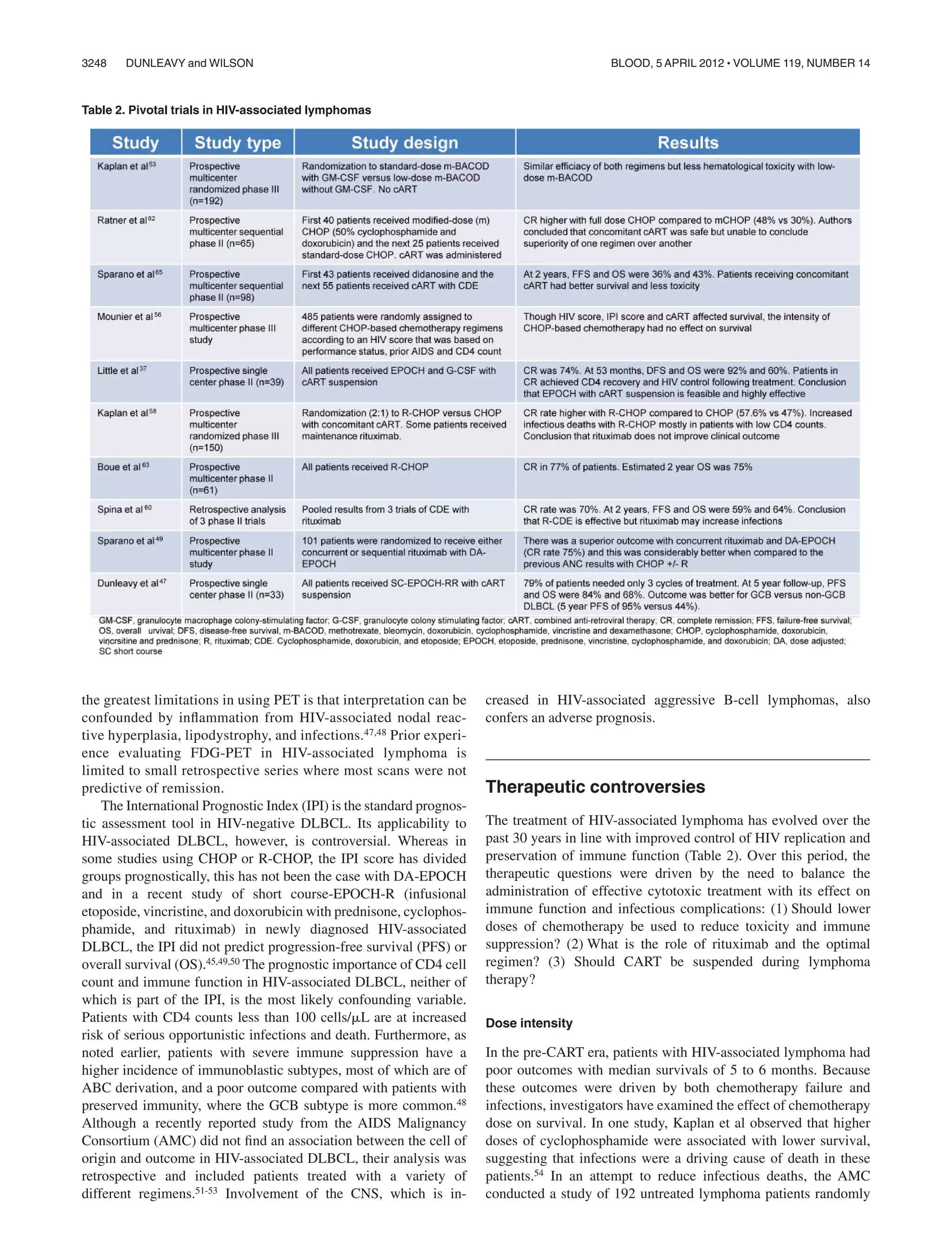
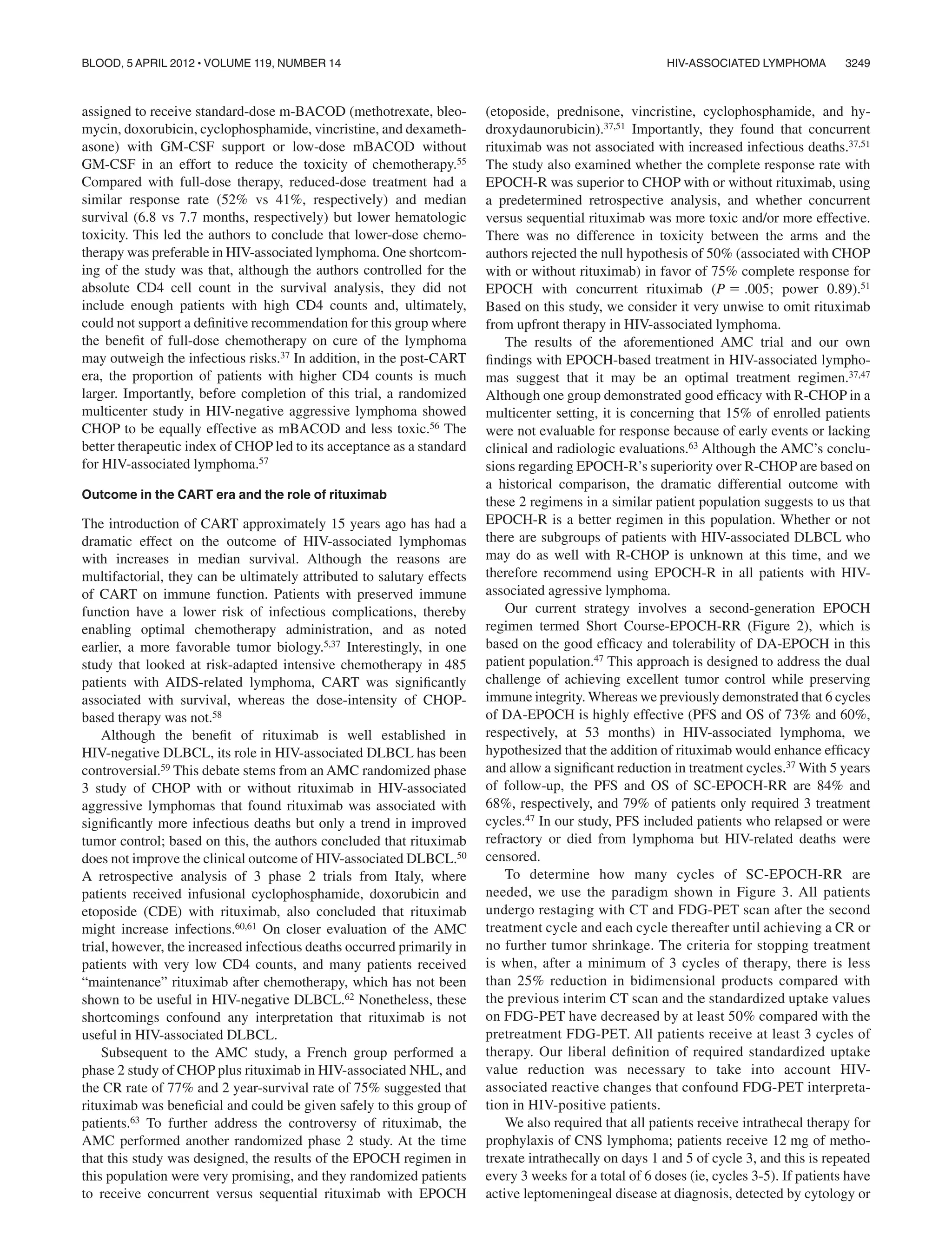
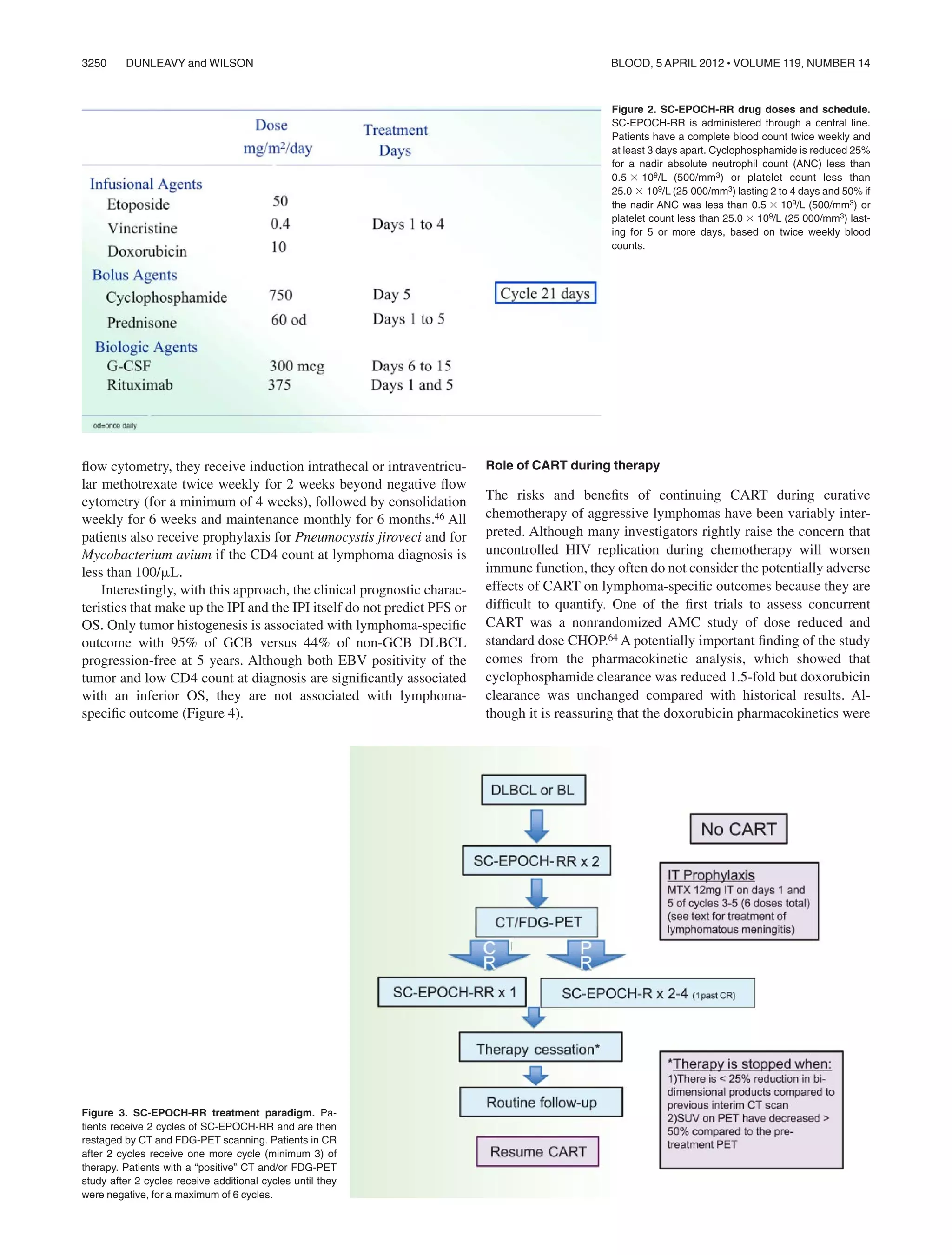
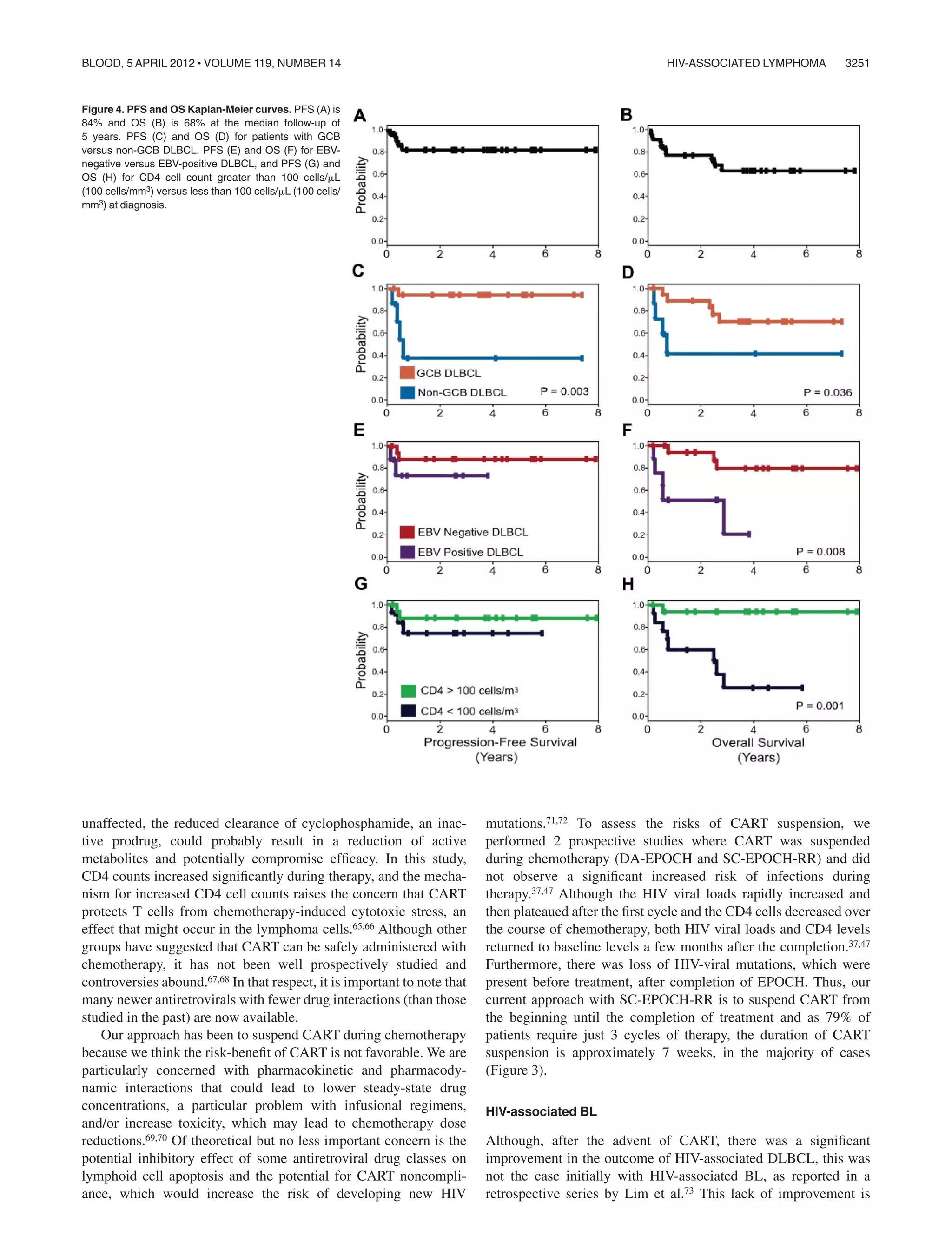
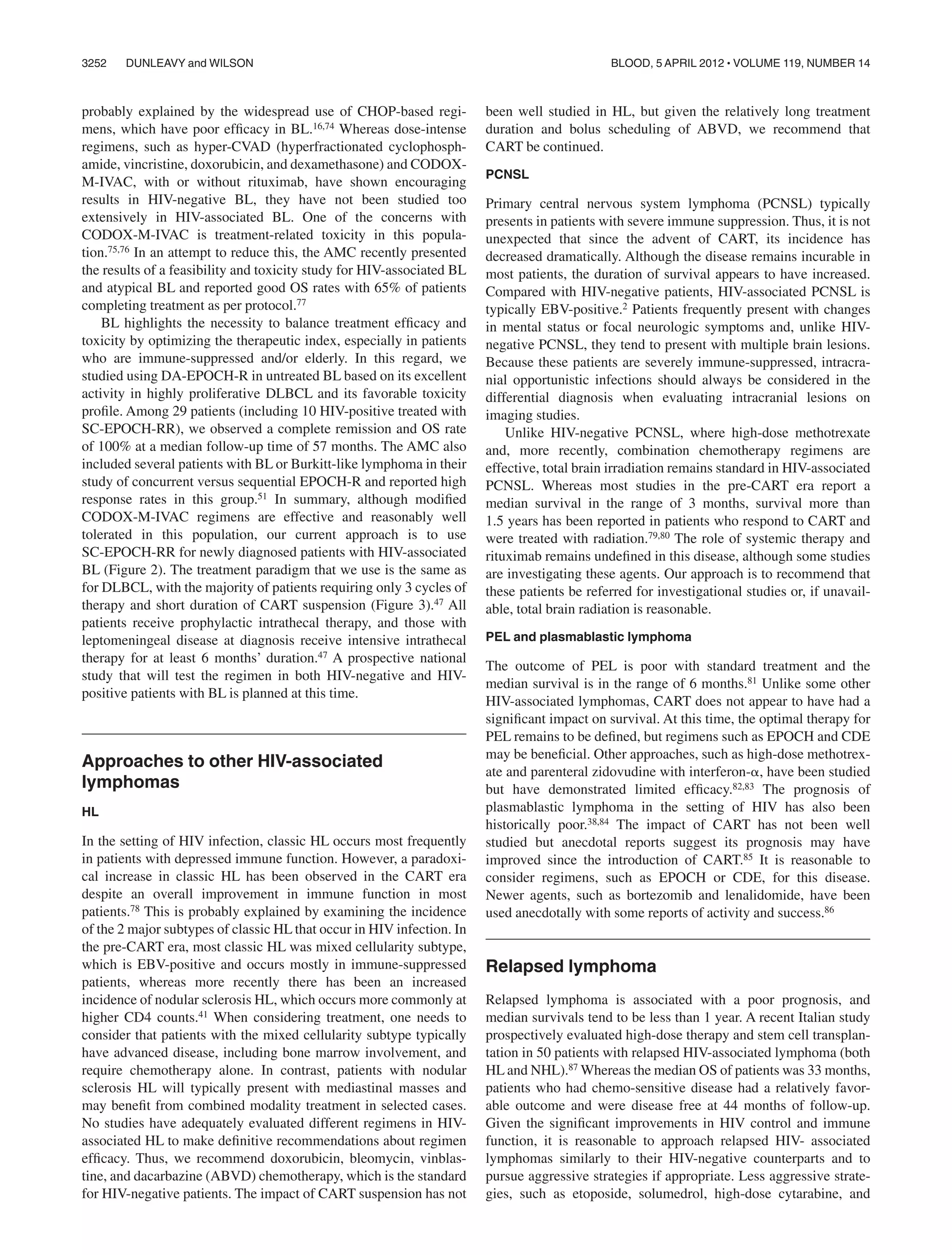
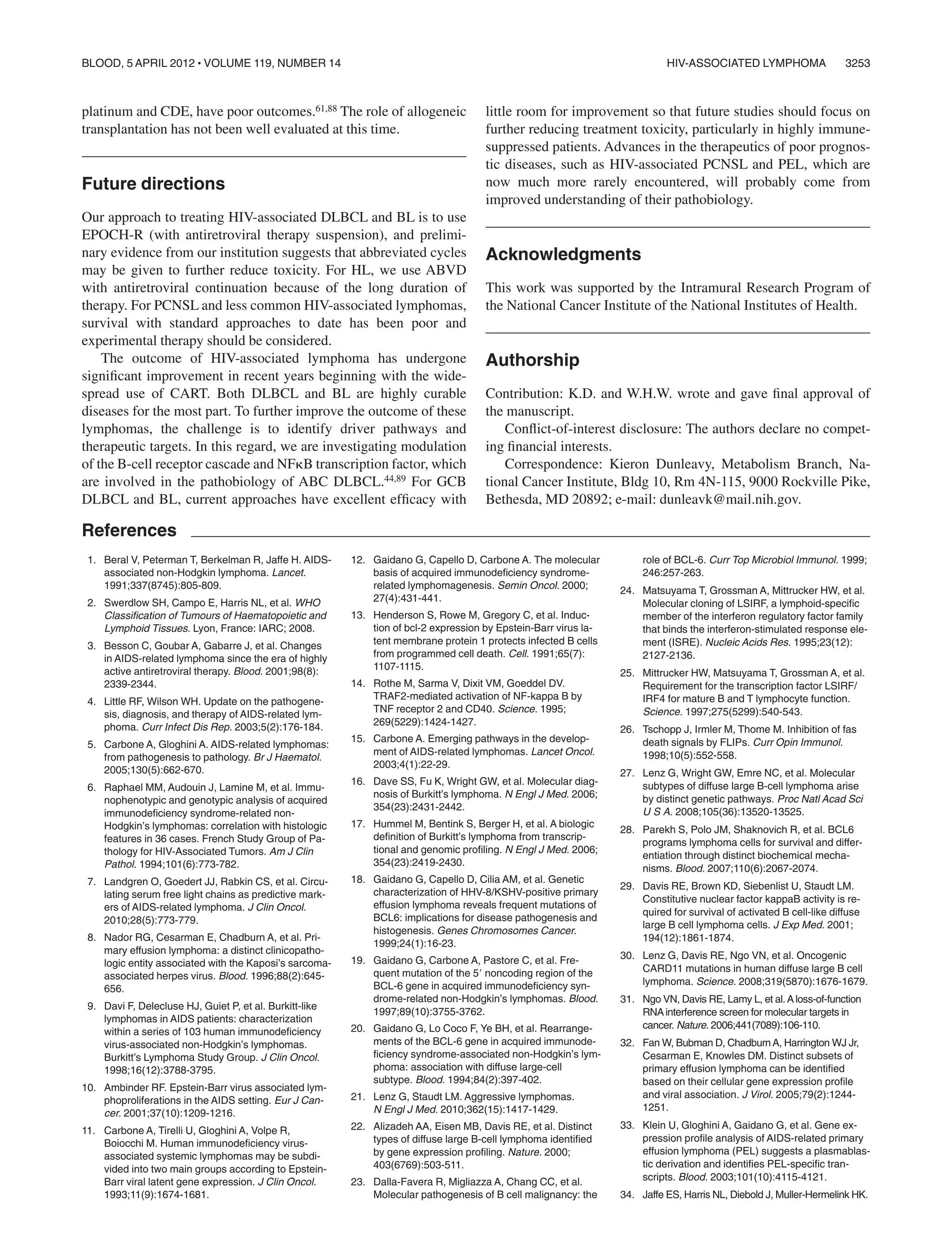
![World Health Organization classification of neo-
plastic diseases of the hematopoietic and lym-
phoid tissues: a progress report. Am J Clin
Pathol. 1999;111(1 suppl 1):S8-S12.
35. Colomo L, Loong F, Rives S, et al. Diffuse large
B-cell lymphomas with plasmablastic differentia-
tion represent a heterogeneous group of disease
entities. Am J Surg Pathol. 2004;28(6):736-747.
36. Vega F, Chang CC, Medeiros LJ, et al. Plasmab-
lastic lymphomas and plasmablastic plasma cell
myelomas have nearly identical immunopheno-
typic profiles. Mod Pathol. 2005;18(6):806-815.
37. Little RF, Pittaluga S, Grant N, et al. Highly effec-
tive treatment of acquired immunodeficiency syn-
drome-related lymphoma with dose-adjusted EP-
OCH: impact of antiretroviral therapy suspension
and tumor biology. Blood. 2003;101(12):4653-
4659.
38. Delecluse HJ, Anagnostopoulos I, Dallenbach F,
et al. Plasmablastic lymphomas of the oral cavity:
a new entity associated with the human immuno-
deficiency virus infection. Blood. 1997;89(4):
1413-1420.
39. Raphael M, Gentilhomme O, Tulliez M, Byron PA,
Diebold J. Histopathologic features of high-grade
non-Hodgkin’s lymphomas in acquired immuno-
deficiency syndrome: the French Study Group of
Pathology for Human Immunodeficiency Virus-
Associated Tumors. Arch Pathol Lab Med. 1991;
115(1):15-20.
40. Thompson LD, Fisher SI, Chu WS, Nelson A,
Abbondanzo SL. HIV-associated Hodgkin lym-
phoma: a clinicopathologic and immunopheno-
typic study of 45 cases. Am J Clin Pathol. 2004;
121(5):727-738.
41. Biggar RJ, Jaffe ES, Goedert JJ, Chaturvedi A,
Pfeiffer R, Engels EA. Hodgkin lymphoma and
immunodeficiency in persons with HIV/AIDS.
Blood. 2006;108(12):3786-3791.
42. Hans CP, Weisenburger DD, Greiner TC, et al.
Confirmation of the molecular classification of
diffuse large B-cell lymphoma by immunohisto-
chemistry using a tissue microarray. Blood. 2004;
103(1):275-282.
43. Choi WW, Weisenburger DD, Greiner TC, et al. A
new immunostain algorithm classifies diffuse
large B-cell lymphoma into molecular subtypes
with high accuracy. Clin Cancer Res. 2009;
15(17):5494-5502.
44. Dunleavy K, Pittaluga S, Czuczman MS, et al.
Differential efficacy of bortezomib plus chemo-
therapy within molecular subtypes of diffuse large
B-cell lymphoma. Blood. 2009;113(24):6069-
6076.
45. Ruan J, Martin P, Furman RR, et al. Bortezomib
plus CHOP-rituximab for previously untreated
diffuse large B-cell lymphoma and mantle cell
lymphoma. J Clin Oncol. 2011;29(6):690-697.
46. Hegde U, Filie A, Little RF, et al. High incidence of
occult leptomeningeal disease detected by flow
cytometry in newly diagnosed aggressive B-cell
lymphomas at risk for central nervous system in-
volvement: the role of flow cytometry versus cy-
tology. Blood. 2005;105(2):496-502.
47. Dunleavy K, Little RF, Pittaluga S, et al. The role
of tumor histogenesis, FDG-PET, and short-
course EPOCH with dose-dense rituximab (SC-
EPOCH-RR) in HIV-associated diffuse large
B-cell lymphoma. Blood. 2010;115(15):3017-
3024.
48. Dunleavy K, Mikhaeel G, Sehn LH, Hicks RJ,
Wilson WH. The value of positron emission to-
mography in prognosis and response assess-
ment in non-Hodgkin lymphoma. Leuk Lym-
phoma. 2010;51(suppl 1):28-33.
49. Ribera JM, Oriol A, Morgades M, et al. Safety and
efficacy of cyclophosphamide, adriamycin, vin-
cristine, prednisone and rituximab in patients with
human immunodeficiency virus-associated dif-
fuse large B-cell lymphoma: results of a phase II
trial. Br J Haematol. 2008;140(4):411-419.
50. Kaplan LD, Lee JY, Ambinder RF, et al. Rituximab
does not improve clinical outcome in a random-
ized phase 3 trial of CHOP with or without ritux-
imab in patients with HIV-associated non-
Hodgkin lymphoma: AIDS-Malignancies Consor-
tium Trial 010. Blood. 2005;106(5):1538-1543.
51. Sparano JA, Lee JY, Kaplan LD, et al. Rituximab
plus concurrent infusional EPOCH chemotherapy
is highly effective in HIV-associated B-cell non-
Hodgkin lymphoma. Blood. 2010;115(15):3008-
3016.
52. Chadburn A, Chiu A, Lee JY, et al. Immunopheno-
typic analysis of AIDS-related diffuse large B-cell
lymphoma and clinical implications in patients
from AIDS Malignancies Consortium clinical trials
010 and 034. J Clin Oncol. 2009;27(30):5039-
5048.
53. Dunleavy K, Wilson WH. Role of molecular sub-
type in predicting outcome of AIDS-related diffuse
large B-cell lymphoma. J Clin Oncol. 2010;
28(16):e260; author reply e261-e262.
54. Kaplan LD, Abrams DI, Feigal E, et al. AIDS-
associated non-Hodgkin’s lymphoma in San
Francisco. JAMA. 1989;261(5):719-724.
55. Kaplan LD, Straus DJ, Testa MA, et al. Low-dose
compared with standard-dose m-BACOD chemo-
therapy for non-Hodgkin’s lymphoma associated
with human immunodeficiency virus infection:
National Institute of Allergy and Infectious Dis-
eases AIDS Clinical Trials Group. N Engl J Med.
1997;336(23):1641-1648.
56. Fisher RI, Gaynor ER, Dahlberg S, et al. Com-
parison of a standard regimen (CHOP) with three
intensive chemotherapy regimens for advanced
non-Hodgkin’s lymphoma. N Engl J Med. 1993;
328(14):1002-1006.
57. Lim ST, Levine AM. Recent advances in acquired
immunodeficiency syndrome (AIDS)-related lym-
phoma. CA Cancer J Clin. 2005;55(4):229-241.
58. Mounier N, Spina M, Gabarre J, et al. AIDS-
related non-Hodgkin lymphoma: final analysis of
485 patients treated with risk-adapted intensive
chemotherapy. Blood. 2006;107(10):3832-3840.
59. Coiffier B, Lepage E, Briere J, et al. CHOP che-
motherapy plus rituximab compared with CHOP
alone in elderly patients with diffuse large-B-cell
lymphoma. N Engl J Med. 2002;346(4):235-242.
60. Spina M, Jaeger U, Sparano JA, et al. Rituximab
plus infusional cyclophosphamide, doxorubicin,
and etoposide in HIV-associated non-Hodgkin
lymphoma: pooled results from 3 phase 2 trials.
Blood. 2005;105(5):1891-1897.
61. Spina M, Vaccher E, Juzbasic S, et al. Human
immunodeficiency virus-related non-Hodgkin lym-
phoma: activity of infusional cyclophosphamide,
doxorubicin, and etoposide as second-line che-
motherapy in 40 patients. Cancer. 2001;92(1):
200-206.
62. Dunleavy K, Wilson WH, Kaplan LD. The case for
rituximab in AIDS-related lymphoma. Blood.
2006;107(7):3014-3015.
63. Boue F, Gabarre J, Gisselbrecht C, et al. Phase II
trial of CHOP plus rituximab in patients with HIV-
associated non-Hodgkin’s lymphoma. J Clin On-
col. 2006;24(25):4123-4128.
64. Ratner L, Lee J, Tang S, et al. Chemotherapy for
human immunodeficiency virus-associated non-
Hodgkin’s lymphoma in combination with highly
active antiretroviral therapy. J Clin Oncol. 2001;
19(8):2171-2178.
65. Johnson N, Parkin JM. Anti-retroviral therapy re-
verses HIV-associated abnormalities in lympho-
cyte apoptosis. Clin Exp Immunol. 1998;113(2):
229-234.
66. Phenix BN, Angel JB, Mandy F, et al. Decreased
HIV-associated T cell apoptosis by HIV protease
inhibitors. AIDS Res Hum Retroviruses. 2000;
16(6):559-567.
67. Sparano JA, Lee S, Chen MG, et al. Phase II trial
of infusional cyclophosphamide, doxorubicin, and
etoposide in patients with HIV-associated non-
Hodgkin’s lymphoma: an Eastern Cooperative
Oncology Group Trial (E1494). J Clin Oncol.
2004;22(8):1491-1500.
68. Vaccher E, Spina M, di Gennaro G, et al. Con-
comitant cyclophosphamide, doxorubicin, vincris-
tine, and prednisone chemotherapy plus highly
active antiretroviral therapy in patients with hu-
man immunodeficiency virus-related, non-
Hodgkin lymphoma. Cancer. 2001;91(1):155-163.
69. Tulpule A, Sherrod A, Dharmapala D, et al. Multi-
drug resistance (MDR-1) expression in AIDS-
related lymphomas. Leuk Res. 2002;26(2):121-
127.
70. Wilson WH, Bates SE, Fojo A, et al. Controlled
trial of dexverapamil, a modulator of multidrug
resistance, in lymphomas refractory to EPOCH
chemotherapy. J Clin Oncol. 1995;13(8):1995-
2004.
71. Phenix BN, Cooper C, Owen C, Badley AD.
Modulation of apoptosis by HIV protease inhibi-
tors. Apoptosis. 2002;7(4):295-312.
72. Phenix BN, Lum JJ, Nie Z, Sanchez-Dardon J,
Badley AD. Antiapoptotic mechanism of HIV pro-
tease inhibitors: preventing mitochondrial trans-
membrane potential loss. Blood. 2001;98(4):
1078-1085.
73. Lim ST, Karim R, Nathwani BN, Tulpule A,
Espina B, Levine AM. AIDS-related Burkitt’s lym-
phoma versus diffuse large-cell lymphoma in the
pre-highly active antiretroviral therapy (HAART)
and HAART eras: significant differences in sur-
vival with standard chemotherapy. J Clin Oncol.
2005;23(19):4430-4438.
74. Bishop PC, Rao VK, Wilson WH. Burkitt’s lym-
phoma: molecular pathogenesis and treatment.
Cancer Invest. 2000;18(6):574-583.
75. Barnes JA, Lacasce AS, Feng Y, et al. Evaluation
of the addition of rituximab to CODOX-M/IVAC for
Burkitt’s lymphoma: a retrospective analysis. Ann
Oncol. 2011;22(8):1859-1864.
76. Cortes J, Thomas D, Rios A, et al. Hyperfraction-
ated cyclophosphamide, vincristine, doxorubicin,
and dexamethasone and highly active antiretrovi-
ral therapy for patients with acquired immunodefi-
ciency syndrome-related Burkitt lymphoma/
leukemia. Cancer. 2002;94(5):1492-1499.
77. Noy A, Kaplan L, Lee J. Feasibility and toxicity of
a modified dose intensive R-CODOX-M/IVAC for
HIV-associated Burkitt and atypical Burkitt lym-
phoma (BL): preliminary results of a Prospective
Multicenter Phase II Trial of the AIDS Malignancy
Consortium (AMC) [abstract]. ASH Annual Meet-
ing Abstracts. 2009;114:3673.
78. Bohlius J, Schmidlin K, Boue F, et al. HIV-1-
related Hodgkin lymphoma in the era of combina-
tion antiretroviral therapy: incidence and evolu-
tion of CD4ϩ T-cell lymphocytes. Blood. 2011;
117(23):6100-6108.
79. Hoffmann C, Tabrizian S, Wolf E, et al. Survival of
AIDS patients with primary central nervous sys-
tem lymphoma is dramatically improved by
HAART-induced immune recovery. AIDS. 2001;
15(16):2119-2127.
80. Ling SM, Roach M 3rd, Larson DA, Wara WM.
Radiotherapy of primary central nervous system
lymphoma in patients with and without human
immunodeficiency virus: ten years of treatment
experience at the University of California San
Francisco. Cancer. 1994;73(10):2570-2582.
81. Boulanger E, Gerard L, Gabarre J, et al. Prognos-
tic factors and outcome of human herpesvirus
8-associated primary effusion lymphoma in pa-
tients with AIDS. J Clin Oncol. 2005;23(19):4372-
4380.
82. Boulanger E, Daniel MT,Agbalika F, Oksenhendler E.
Combined chemotherapy including high-dose
methotrexate in KSHV/HHV-8-associated primary
effusion lymphoma. Am J Hematol. 2003;73(3):
143-148.
83. Ghosh SK, Wood C, Boise LH, et al. Potentiation
of TRAIL-induced apoptosis in primary effusion
3254 DUNLEAVY and WILSON BLOOD, 5 APRIL 2012 ⅐ VOLUME 119, NUMBER 14](https://image.slidesharecdn.com/l2-140613130828-phpapp01/75/Linfomas-y-VIH-II-11-2048.jpg)
